Introduction
We encourage you to verify the source images for yourself, rather than just simply accept the facts that are presented here.
Exact details of the used image templates can be found here.
Some reports on this website are based on previous ones. So it is extremely important to read the reports in chronological order.
Details can turn up that were probably already been analyzed in detail. If you are new here and you directly start reading the
recent reports without prior knowledge, then it could happen, that the required context is not recognizable.
You do yourself and us a favor when you first start with the oldest reports.
This report makes reference to structure anomalies, that have been discovered in Aram Chaos. We recommend that you also
review the previous reports, if you have not read them yet.
The following documents are relevant:
Style Comparisons - The Snake Heads of Aram Chaos
The monument of a multi-headed dragon/serpent being in Aram Chaos shows us the first time in a very impressive way
an example of extraterrestrial art. It can be assumed that the construction of such a monument has probably a religious background.
The corresponding large dragon head, whose mouth is probably an entrance, has great symbolical and psychological significance.
Interesting is the fact that the reconstructed head formations are not designed in the same way,
but each of them shows a different style.
 Click on image to enlarge
Click on image to enlarge
Of the six presumably former smaller head formations only three can still be recognized. Looking at the right head
of the remained formations, we see a very realistic shaped snake head. Very impressive are the many small details,
their equivalents can also be found on real snakes. The facet-like shed in the area around the nose, the round eye, and even
a circular opening in the jaw exists. In snakes, the trachea (air tube) ends inside their mouth. The opening of this tube is
Called glottis. This allows the snakes to produce the typical sibilants.
 Click on image to enlarge
Click on image to enlarge
The middle head formation, however, shows a more artistic interpretation of a snake head. Predominant feature are circular
googly eyes and instead of the expected two large fangs there are almost human-looking teeth. Such depictions of snakes
can be frequently found in seven-headed snake statue (Nagas) in the Southeast Asian region.
 Click on image to enlarge
Click on image to enlarge
The classification of the left formation is difficult here, since the structure shows massive damages. Special features are the
almond-shaped eyes and a seemingly wide-open mouth. But also here, we can find snake statues from the Southeast Asian region with the same
similar characteristics.
 Click on image to enlarge
Click on image to enlarge
In all these comparisons it should not be overlooked that the snake statues represent only tiny versions, compared with
the huge monument on Mars. Even the changing look of each of the snake heads is, compared to the multi-headed naga statues
here on earth, from the viewpoint of stylistic means a completely atypical feature. This includes the arrangement of the heads,
where we usually find a large head in the middle and next to this large head, on both sides, an even number
of smaller heads. With its special head arrangement, the Monument in Aram Chaos owns a unique artistic feature.
Prohibited Matches - Mesopotamia / Mesoamerica
So far, based on indications that have been found on the Mars images, we looked for similarities in our cultural history.
An approach that has actually delivered insightful information.
Pathbreaking was the symbol of the winged sun disk, the eight spoke wheel or derived cross symbols such as
the Maltese cross. It were these symbols, which showed a connection between different cultures.
There always seem to appear the same religious/cultic aspects.
Regardless of the Martian discoveries, an investigation of different symbols should show whether further striking similarities between ancient
civilizations can be found that actually never had contact with each other, according to official doctrine. It is an attempt to
find new evidences, by going this inverse proceeding. In turn, we can search specifically for appropriate similarities on Mars images.
It is considered as excluded that there was a cultural link between Mesopotamia and Mesoamerica.
For both cultural landscapes there was at no time of its existence given the technical possibility to get in touch with each other.
Nevertheless, both have a large number of similarities.
The following figure shows a part of the upper section of a stone tablet. Here we can see the Babylonian sun god Shamash.
The tablet is dated from the ninth century before Christ. Three symbolic circles are visible over Shamash's head.
Starting at the left the first symbol represents the moon, which stands for the Babylonian moon god Sin (equivalent to the Sumerian god Nanna).
The second symbol represents the sun god Shamash itself, here in the shape of a four pointed star with four undulating runners.
Another alternative representation of the symbol of Shamash is a cross-representation that resembles the shape of the Maltese cross
Stone tablet with the Assyrian king Shamsi Adad V (about 820 BC). Emblazoned on his chest
the symbol of Shamash in the shape of a Maltese cross
.
The third symbol is the so-called Star of Ishtar. As the personification of the planet Venus she was also Sins daughter and the sister of Shamash.
In an variant Ishtar is also introduced as the goddess of love and war simultaneously.
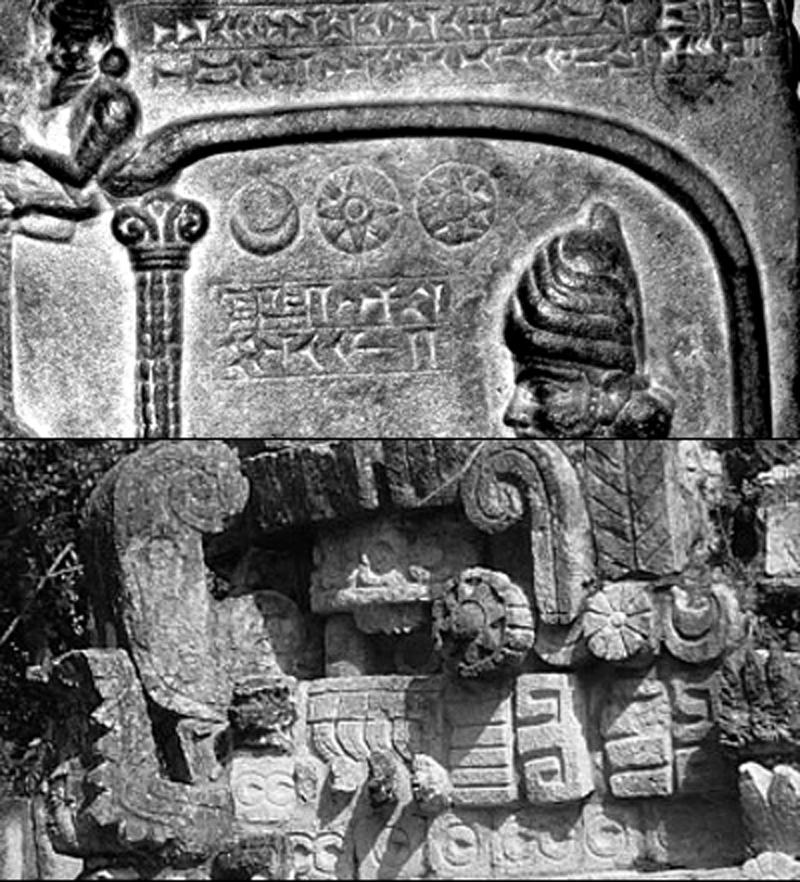 Click on image to enlarge
Click on image to enlarge
A triple coincidence? The lower image part is from Labna, an archaeological ruin in the Yucatan Peninsula in Mexico.
The shown symbol combination is located at the east wing of the palace ruin. The meaning of these symbols is not known.
Therefore, it is interpreted as a kind of rosette embellishments. However, if we consider the surrounding symbols and figures,
these embellishments can hardly be described just as simple decorations.
Prohibited Matches - Mesoamerica / Central and East Asia
Next to the symbol circles that can be found at the palace of Labna, there is still another detail which turns out to be still
extremely unusual. This includes a mouth, provided with sharp teeth, from where a human countenance looks out, showed in the following image.
On closer inspection one can realize that this is just a part of a huge face. The corresponding
long proboscis-shaped, curved nose assigns this figure as a manifestation of the rain and fertility god Chaac
 .
This corresponds to the god Tlaloc .
This corresponds to the god Tlaloc
 in the Aztec culture. in the Aztec culture.
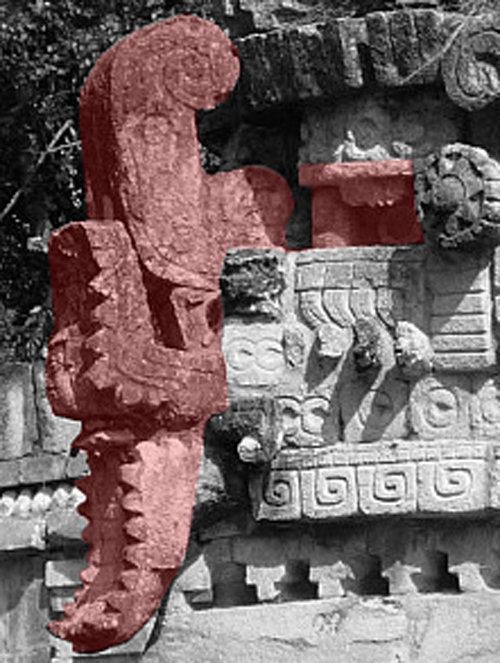
Depiction of Chaac from the ruins in Labna, Mexico
Chaac represents a very important divinity in the life of the Maya and is therefore a fundamental part of artistic decorations in
Maya temples. The so-called Chaac masks are often placed at doorways and at corners. The following image shows another example of a Chaac
depiction at the corner facade of the temple building called "Iglesia", located in the ruins Chichen Itza.
 Here with lying "nose" and a broad jaw.
Here with lying "nose" and a broad jaw.
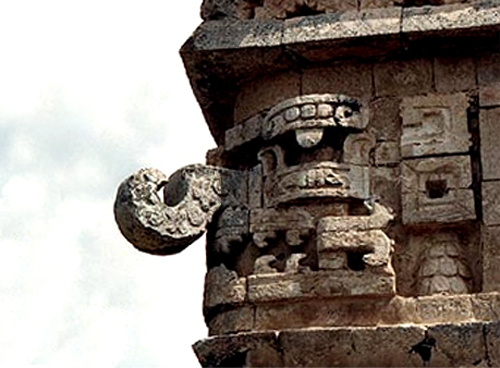
Depiction of Chaac from the ruins in Chichén Itzá, Mexico
Many depictions of the Mesoamerican culture area using the motif of the snake-like being
from whose mouth a human countenance peers out
Artistic representation of the Mayan God Kulkukan in the shape of the feathered serpent.
From its mouth the human countenance of Kukulkan peers out - Ruins of Uxmal, Mexico.
.
This symbolic motif is even applied by some depictions with crocodile-like creature. The symbolism can be transferred to the
depiction of Chaac at the palace of Labna. Here it is important to note that likewise the depiction of Chaac is connected with
the characteristics of a crocodile.
Image detail 1: Front view of the crocodile's mouth, showing a face inside (from the palace ruin in Labna).
Image detail 2: Crocodile figurine from the ruins of Lamanai. Exhibited in the Belize City Museum.
Image detail 3: Maya god riding on a crocodile. Exhibition piece from the Kimbell Art Museum in Fort Worth, Texas.
Summarized again: With the example of deity Chaac we have a reptile-like deity whose image is placed above temple entrances and on the
corners. Physical attributes, similar to that of a crocodile, creates the relationship with the element water.
Thus, Chaac is the god of rain and fertility. The image of this amphibious being is also in use as a mount for deities. Another striking
feature is the curved, proboscis-like nose.
What would it mean if all these aspects can be found in other cultural groups?
In cultural groups in which the official doctrine says that they never have been in contact with each other?
Could common archetypal ideas still serve as an explanation for this, if such parallels can be contiously found, showing
exactly the same details?
In Sanskrit, the term Makara describes a so-called sea dragons In written records and artistical depictions
this creature is often shown with attributes of a crocodile.
Seen mythologically, the Makara is the mount of the Vedic water god Varuna and the river goddess Ganga. The Makara is also the
tenth of the Indian zodiac symbol. Interestingly, this represents a parallel to our familiar twelve zodiac signs.
In the tenth place stands the Capricorn, which is located between the constellations of Aquarius and Sagittarius. The illustration in
shape of a goat was introduced in the Roman period, as such, because previously it was known as sea goat or goat fish.
This type of representation was common among the Greeks and it can be also found among the Babylonians in this special shape.
Thus, in Greek mythology, the sea goat is a manifestation of the pastoral god Pan. Zeus personally bequeathed Pan a place in the starry sky.
Artistic depictions show the Makara as a hybrid creature that combines various animal forms. Characteristic features among others are
the mouth, that is similar to that of a crocodile and a extension, which is shaped like a trunk, or, as in some representations,
actually is a trunk. Other forms of presentation show the Makara head with two horns and with the front paws of a lion,
which in turn exactly corresponds to the characteristics that the Babylonians defined for dragon creature. The boundaries appear to be blurred.

To enlarge click on one of the images
In Lhasa, the capital of the autonomous region of Tibet, every corner of the gilded roof at the Jokhang Temple is decorated with the figure of a Makara.
Due to the trunk-like shaped nose, the Makara is also shown with features of an elephant.
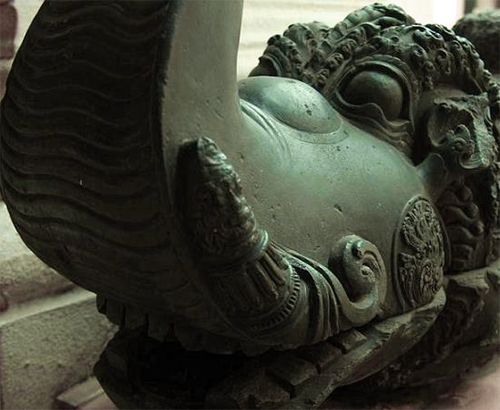
Makara with the features of an elephant (Exhibited in the Indian Museum of Calcutta)
For further cultural comparisons it is extremely important to know that the Maraka is also interpreted as a kind of an elephant-like being.
Looking at other cultures in Asia, we can also find a rain and fertility god. The origin of this deity
can be traced back to the Hinduism. Travelling Brahmins (priests) have significantly contributed to the spread of the Hinduism.
Especially in the eastern part of Asia they have caused a significant proliferation.
In the Hindu mythology, Indra represents a deity who is worshiped as the giver of rain. The annual monsoon rain is
attributed to his actions. Due to this, he is also responsible for the aspect of fertility. Even today the god figure Indra can
be found in vast areas of Asia, which were influenced by Hinduism. However, within these countries there are different names for him.
In Burma he is known under the name Thagyamin, in Thailand as Phra Inn and in Japan as Taishakuten.
In Buddhism his character is known by the name Vajrapani (carrier of the Vajra/Thunderbolt) where he is classified as one of the
eight Bodhisattvas. It is also interesting to note that the mount of Indra is Airvata - an divine elephant being.
There is a statue in the Toji Temple of Kyoto in Japan showing Taishakuten (respectively Indra) sitting on the back of an elephant.
The depictions of Indra sitting on his mount (and those of his subsidiaries) seems to pick up
certain characteristics again and again. Thus Indra is often shown with one leg drawn in and with his holy weapon, the
Vajra, in his hand. The design of this weapon is versatile. Depending on representation it shows a bar, a scepter or a mace.
With regard to the water and river gods Varuna and Ganga, they often carry water pots in their hands. This symbolism also applies
to the Mayan god Chaac. Clay figures show Chaac with the same water pots in his hands.
Image detail 1: Mayan rain god Chaac
Image detail 2: The Indian water god Varuna on his mount
Image detail 3: Mayan Jaguar God riding a 'crocodile'. Also the Jaguar God has the power of the earth forces rain, lightning and thunder
Image detail 4: River goddess Ganga on her mount
Image detail 5: Taishakuten (derived from the rain god Indra) sitting on his mount
Click on image to enlarge
It is obvious that we have the same basic idea here. The concepetion of a rain god in different cultures can certainly be
explained by archetypal ideas. Archetypal ideas, however, can not explain such significant matches between these figures,
With all necessary respect, this can be regarded as highly unusual.
Prohibited Matches - Egypt / Mesoamerica
In the mythology of the ancient Egyptians the crocodile is also a divine form of appearance. Here we can name
the crocodile god Sobek. He is the ruler of the water, who is also revered as a god of fertility.
On depictions Sobek appeares with a human body and the head of a crocodile. Characteristic for him is his lavish
headdress, consisting of the double feather crown, ram's horns, two uraeus wearing the sun for each symbol, and a large sun-disk.
Thus Sobek also combines the aspects of the sun god Re in himself.
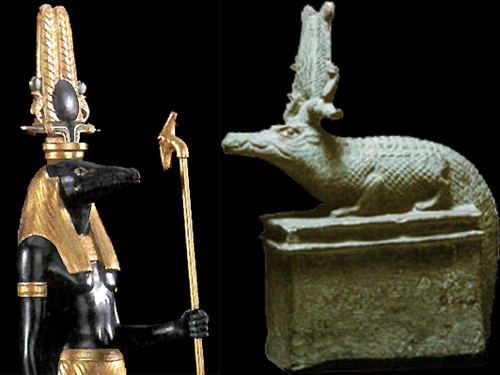
Sobek as a human-reptilian hybrid and in crocodile form
An expansive designed headdress is also a characteristic of the deities in the Mesoamerican cultures. In relation to the
previously shown images, the clay figure of the Mayan god Chaac shows two snakes placed on each side of his headdress.
Also noticeable in the general view is the headdress of the Jaguar deity who rides on a snout-nosed crocodile.
Here we can see two circle symbols, which rest on a snake-like object. Possibly, the circles represent sun symobls,
as solar aspects are also associated with the jaguar god.
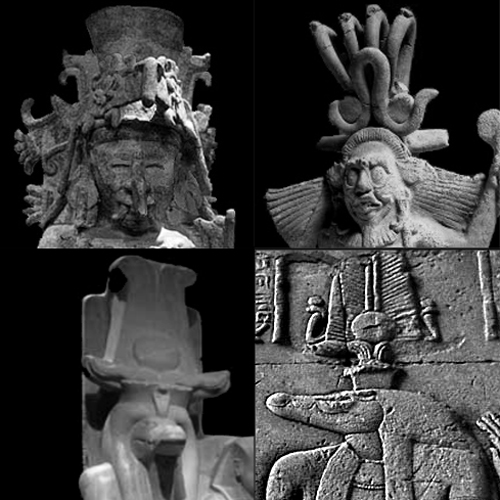
Conceptual matches?
This example shows striking conceptual similarities of the headdress between the Mesoamerican and Egyptian deities. The different cultural
styles gives the impression of totally different and possibly even completely contradictory notions of culture, but a closer look
reveals surprising parallels.
Prohibited Matches - Conclusion
If someone had found the stone relief from Labna, in Syria for example, then the archeologists would associate this set of symbols
with the gods Sin, Shamash and Ishtar.

Matching circle symbols
If someone had found the stone relief in Indonesia
then the snout-nosed corner figure would be regarded as a Makara. Of course, the cutural styles of the Maya differ considerably from those
cultures that are Hindu-Buddhistic influenced or those of the Mesopotamian culture landscape, but the parallels can not be overlooked.
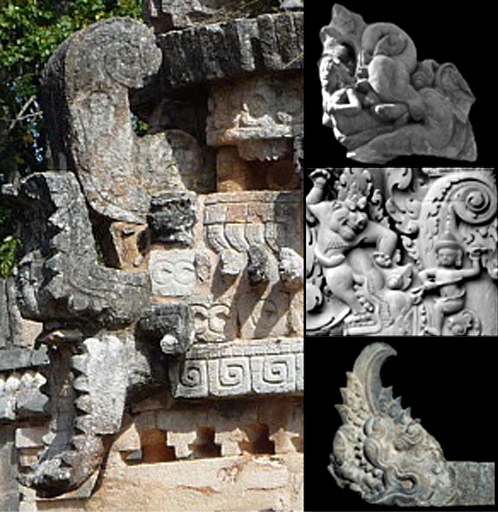
Comparison of Chaac mask with Makaras from Asia
At this point, once again we are confronted with the question whether these are just coincidences or not. Perhaps these similarities
are related with archetypal notions, which are inherent in all people and thus explains why cultures independently develop the same symbols,
characters and stories. It is not obvious that the mythologies of the gods around the world have a common origin?
|

